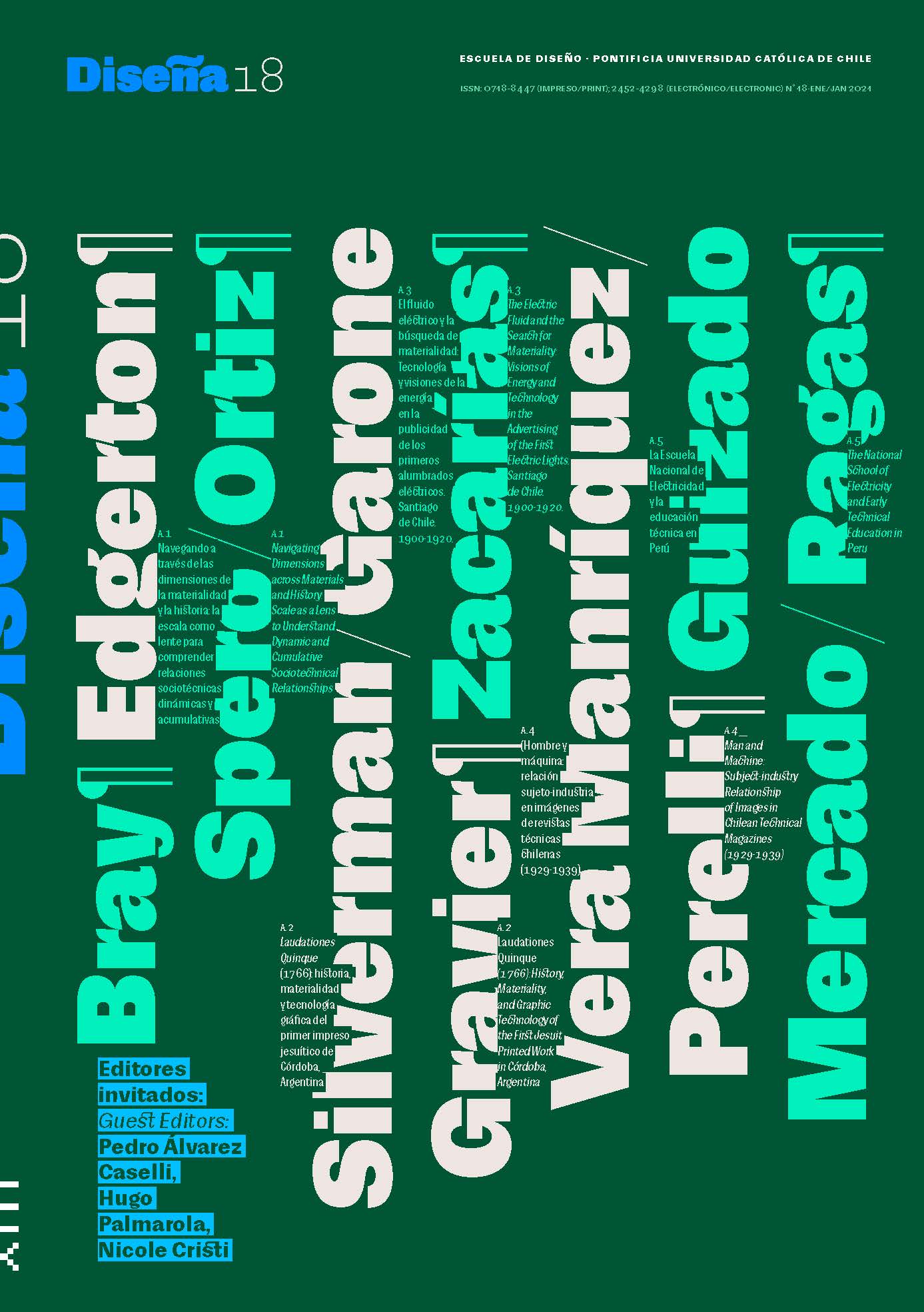Laudationes Quinque (1766): History, Materiality, and Graphic Technology of the First Jesuit Printed Work in Córdoba, Argentina
Main Article Content
Abstract
This text describes the location and identifies the material characteristics of the only known copy of Laudationes Quinque. The book (1766) is the first printed work in the city of Córdoba during the colonial period, a city that belonged to the Rio de la Plata Viceroyalty (currently Argentina). A visual analysis of the document was carried out employing the material perspective, considering the graphic technology elements of the old manual press, and observing from a graphic design perspective. This analysis revealed compositional aspects of the pages and graphic communication elements that have been frequently relegated by historians and bibliographers. This work builds upon a previous study that was carried out from a facsimile. Therefore, we take those results as preliminary and now we offer broader findings based on material analysis.
Downloads
Article Details

This work is licensed under a Creative Commons Attribution-ShareAlike 4.0 International license.
COPYRIGHT NOTICE
All contents of this electronic edition are distributed under the Creative Commons license of "Attribution-ShareAlike 4.0 Internacional" (CC-BY-SA). Any total or partial reproduction of the material must mention its origin.
The rights of the published images belong to their authors, who grant to Diseña the license for its use. The management of the permits and the authorization of the publication of the images (or of any material) that contains copyright and its consequent rights of reproduction in this publication is the sole responsibility of the authors of the articles.
References
BALMACEDA, J. C. (1998). Las filigranas de los primeros impresos de Buenos Aires. In P. F. Tschudin (Ed.), Papers of the 24th International Congress of Paper Historians (Vol. 12, pp. 220-255). http://www.cahip.org/cahip_expositos.htm
BITECA. (2018). Biteca-Filigrana-043001. http://stel.ub.edu/biteca/filigranes/ca/043001.html#
Cinco oraciones laudatorias en honor del Dr. D. Ignacio Duarte y Quirós (facsimile edition). (1937). Universidad Nacional de Córdoba. Colección de la Imprenta Jesuítica del Colegio de Monserrat, I.
CREMONINI, G., SILVERMAN, D., & G ARONE GRAVIER, M. (2016). Brevis vita typographica: La imprenta jesuita del Colegio de Monserrat en Córdoba, Argentina. Progressus, Rivista Di Storia Scrittura e Società, III(2), 107–136.
DUFFNER, G. (2014). EB Garamond. http://www.georgduffner.at/ebgaramond/index.html
FORERO, M. J. (1946). Incunables bogotanos: Siglo XVIII. Ministerio de Educación Nacional.
FURLONG CARDIFF, G. (1921). La imprenta jesuítica de Córdoba. Estudios. Revista de la Academia del Plata, 118(21).
FURLONG CARDIFF, G. (1937). El autor de las Laudationes Quinque. In Cinco oraciones laudatorias en honor del Dr. D. Ignacio Duarte y Quirós (pp. 3-68). Universidad Nacional de Córdoba, Instituto de Estudios Americanistas.
FURLONG CARDIFF, G. (1947). Orígenes del arte tipográfico en América, especialmente en la República Argentina. Huarpes.
GARONE GRAVIER, M. (2014a). El comercio tipográfico matritense en México durante el siglo XVIII. Secuencia, 88, 9-36. https://doi.org/10.18234/secuencia.v0i88.1213
GARONE GRAVIER, M. (2014b). Historia de la tipografía colonial para lenguas indígenas. CIESAS-Universidad Veracruzana.
GARONE GRAVIER, M. (2015). Historia de la imprenta y la tipografía colonial en Puebla de los Ángeles, 1642-1821. Instituto de Investigaciones Bibliográficas, UNAM.
GARONE GRAVIER, M. (2016a). Datos históricos de la Imprenta jesuita del Colegio Real de San Ignacio y consideraciones materiales sobre algunas de sus ediciones. Progressus. Rivista di Storia Scrittura e Società, Año III(2), 88-106.
GARONE GRAVIER, M. (2016b). La Imprenta de la Biblioteca Mexicana: Nuevas noticias de un taller tipográfico del siglo XVIII. Bibliographica Americana, 12, 74-90.
GASKELL, P. (1999). Nueva introducción a la bibliografía material. Trea.
IGUÍNIZ, J. B. (1959). Léxico bibliográfico. Instituto Bibliográfico Mexicano.
INSTITUTO DEL PATRIMONIO CULTURAL DE ESPAÑA. (n. d.). Filigranas Hispánicas. Búsqueda de filigranas. Retrieved August 28, 2019, from https://www.mecd.es/filigranas/buscador_init
La primera imprenta rioplatense funcionó en las misiones de Loreto y Santa María la Mayor. Incunables jesuíticos, una historia latinoamericana. (2007, December 9). https://www.clarin.com/sociedad/incunables-jesuiticos-historia-latinoamericana_0_HJA7VhRCpKe.html
LÓPEZ SALDAÑA, A. M. (2008). Incunables peruanos en bibliotecas del país y del extranjero, y adiciones al catálogo Incunables peruanos en la Biblioteca Nacional del Perú (1584-1619). Biblioteca Nacional del Perú.
MORET VIÑALS, O. (2006). El Mitjà tipogràfic [Doctoral Dissertation, Universitat de Barcelona]. http://www.tdx.cat/handle/10803/1379
MORET VIÑALS, O. (2014). Medidas tipográficas: Un recuento. InfoDesign - Revista Brasileira de Design da Informação, 11(2), 134-165.
PAGE, C. A. (2011). Siete ángeles. Editorial SB.
PARDO, O. (2017). EBGaramond12 [Shell]. https://github.com/octaviopardo/EBGaramond12
PAREDES, A. V. de . (ca. 1680/2002). Institución y origen del arte de la imprenta y reglas generales para los componedores. Calambur.
PERAMÀS, J. M. (atribuido) (1766). Clarissimi viri D.D. Ignatii Duartii et Quirosii: Collegii Monsserratensis Cordubae in America conditoris, laudationes quinque / quas eidem collegio regio Barnabas Echaniquius, O.D. [Typis Collegii R. Monserratensis, 1766]. In Biblioteca de Montserrat, Signature Mont*I*8º*83.
REDACCIÓN UTD. (2002, April 11). Grandes maestros de la tipografía: Claude Garamond. UnosTiposDuros. https://www.unostiposduros.com/grandes-maestros-de-latipografia-claude-garamond/
REYES, A. (1946). Letras de la Nueva España. Secretaría de Educación Pública.
ROSARIVO, R. M. (1948). Tratado sobre la divina proporción tipográfica ternaria en la unidad artística del libro. Published by the Author.
SILVERMAN, D., CREMONINI, G., & G ARONE GRAVIER, M. (2016). Análisis formal y descripción tipográfica de Laudationes Quinque (1766), primer libro impreso en Córdoba, Argentina. Ensayos: Historia y Teoría del Arte, 20(31), 95-125.
TORRE VILLAR, E. DE LA. (1987). Breve historia del libro en México. Universidad Nacional Autónoma de México.
TSCHICHOLD, J. (1956). Die Proportionen des Buches. In Der Druckspiegel (pp. 8–18,87–96,145–150). Stuttgart.
VALTON, E. (1935). Impresos mexicanos del siglo xvi (incunables americanos) en la Biblioteca Nacional de México, el Museo Nacional y el Archivo General de la Nación: Estudio bibliográfico precedido de una introducción sobre los orígenes de la imprenta en América. Ediciones de la Biblioteca Nacional de México.
WAGNER, H. R. (1940). Nueva bibliografía mexicana del siglo XVI: Suplemento a las bibliografías de don Joaquín García Icazbalceta, don José Toribio Medina y don Nicolás León (J. García Pimentel & F. Gómez de Orozco, Trans.). Polis.
YHMOFF CABRERA, J . (1990). Los impresos mexicanos del siglo XVI en la Biblioteca Nacional de México. Instituto de Investigaciones Bibliográficas, UNAM.

